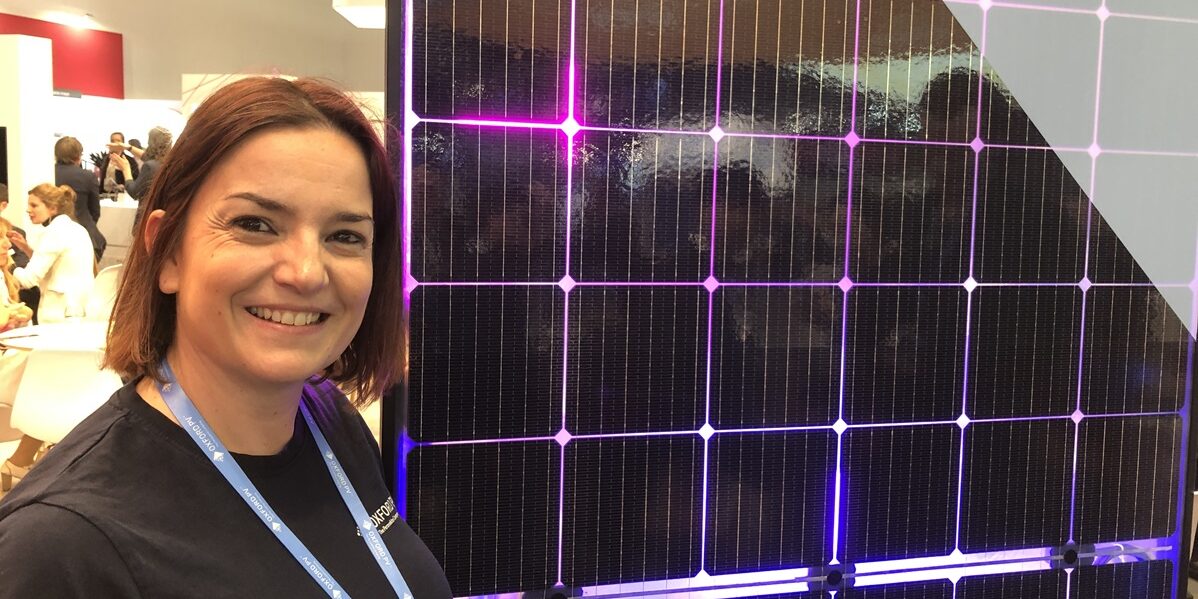
At Intersolar Europe in Munich, several companies presented their concepts for high-performance perovskite tandem photovoltaics. The first modules are expected to be available in the second half of the year. The different approaches by manufacturers are evident.
From pv magazine Germany
Anyone who walked through the halls of Intersolar Europe in Munich with their eyes open could discover, in addition to standard module technologies such as Topcon and heterojunction, double-sided and with back contacts, other modules that are not in line with the mainstream and are currently waiting for a breakthrough. Particularly striking were Megasol’s colored Morpho Color modules, which were exhibited not only in brilliant glitter colors but also in variable cuts for roofs and facades. The Swiss manufacturer also presented its new white solar module for the first time. According to the manufacturer, the colored modules can achieve up to 94% of the output of standard black modules.
The future tandem modules are expected to score points without any loss of performance, but with a significant increase in efficiency. Prototypes from Oxford PV, Huasun, Microquanta, GCL, and others were already on display at the trade fair.
Oxford PV has already discontinued production of its first generation of perovskite tandem modules and will launch the second generation in the second half of the year. The standard-sized modules of the Centaur series are expected to have an efficiency of 25%. The roadmap then calls for the third generation, with 26% module efficiency, to be launched in 2026, Laura Miranda Perez, chief communications and sustainability officer, told pv magazine. The warranties for module performance are also expected to increase year after year. The second generation already has a 20-year warranty, and the third generation is even aiming for a 30-year warranty, Miranda Perez said. The company recently announced that it had granted Trinasolar the license to commercialize its technology in the Chinese market.
Oxford PV is pursuing a tandem approach at the cell level. The symmetrical heterojunction base cell is treated with perovskite layers after passivation and then contacted. Interestingly, Oxford PV continues to use undivided full cells. In addition to the Centaur series there will be a Pegasus series. The manufacturer plans to develop particularly high-performance modules for special applications with partners, tailoring them for applications such as space travel, aviation, telecommunications, and other specialized applications.
A similar cell-based approach was evident at the unveiling of the tandem prototype at Huasun. Starting in 2026, the company plans to launch an 800 W module with heterojunction tandem cells. Many details were not disclosed at the launch. However, the company plans to “seamlessly” integrate the perovskite production steps into heterojunction cell production. The low-temperature processes would have a particularly low carbon footprint. The long-term goal is to achieve cell efficiency in mass production of more than 30%.
Chinese company Microquanta, which was represented at Intersolar for the first time, is taking a different approach. The modules, which are already sold in China and are now also expected to gain a foothold in the European market, are designed either as single perovskite or as tandem modules. The single modules have a reddish color and, as glass-glass laminates, are partially transparent. Their output is 140 W to 160 W per square meter. Coated roof tiles with lower output are also available.

Image: Cornelia Lichner/pv magazine
In the tandem module, the perovskite thin film is located above the silicon cell layer of the module. Both the silicon and the perovskite layers also have their own connection boxes because the outputs of the respective layers are too different. A string of such modules therefore requires two inverters, one for the perovskite and one for the silicon photovoltaics, as Yang Chen, director of overseas business development, explained. Microquanta already operates a perovskite production facility with an annual production capacity of 100 MW.
GCL also presented a single and a tandem module with a similar approach in Munich. The single prototype has an efficiency of 19.04% at a size of 2 meters by 1 meter. The tandem module is expected to have an efficiency of 26.36% at the same size. GCL plans to bring the modules to market in 2026 and is working on, among other things, enabling the two connectors to be connected to an inverter with two MPPTs.
The race for the tandem modules has therefore begun, and in addition to the question of who can deliver the highest power fastest, there is also the question of the best route to the goal.
This content is protected by copyright and may not be reused. If you want to cooperate with us and would like to reuse some of our content, please contact: editors@pv-magazine.com.
Source link


